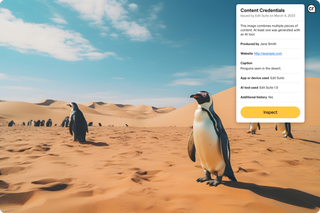Adobe Max 2023 unveils AI-powered editing tools that can make almost anything from text prompts
The three-day Adobe Max 2023 event in Los Angeles is in full swing, and the leading name in digital photo, video and design suites unveiled major updates to its Creative Cloud, including – you guessed it – the latest AI-powered machining and generation tools.
Adobe’s Creative Cloud, which includes Photoshop, Lightroom, Premiere Pro and Illustrator, received a bumper update this year and the next generation of Firefly is playing a leading role. There’s too much to sensibly discuss here, so let’s take a closer look at the headlines for the respective platforms.
Adobe’s next generation Firefly
In the short video (above), Aya, an Adobe Product Manager at ‘Project Stardust’, talks us through Adobe’s new object-aware editing engine that will “revolutionize the way we interact with Adobe products.”
The video shows an image file being imported into the next generation Firefly editor, where AI-powered non-destructive editing can be performed. A yellow suitcase in a model’s hand is selected and becomes a new layer that can be moved or deleted within the frame, intelligently filling in the background space left behind.
We are then guided through generative word prompts, placing yellow flowers in the model’s hands instead of the suitcase. In another example (below), we see Firefly’s improved image generation capabilities.
All this in itself is nothing new, and it is clear even from the first demo on a small screen that there are artifacts where the yellow suitcase has been removed, but the ease with which these edits can be made seems to be on another level than that of Adobe beta AI Firefly interface.
Firefly works in Photoshop, Express and Illustrator and includes the world’s first generative AI for vector graphics, which converts text to vector graphics in Illustrator, with editable images including icons, scenes and patterns.
Simply put, the latest Firefly engine seems smarter, more versatile and more powerful, with a better understanding of text prompts that can create commercially useful assets just from a sentence of text. Firefly can recognize more landmarks and cultural symbols, provide guidance on expanding or rephrasing a prompt, and produce better results. It’s not perfect, but it’s certainly impressive and it puts Adobe one step ahead of the competition.
Beyond Firefly’s generative AI, Adobe has added a host of tools for Photoshop and Lightroom. In the promo video (above), Adobe shows off a new Lens Blur tool for Lightroom, which works a lot like a smartphone’s portrait mode, blurring the background to help subjects stand out from their surroundings. The shape of the bokeh (out-of-focus points of light) can be changed to one of five options, including perfect circles – again a tool seen on flagship devices like the Huawei P60 Pro.
Other Lightroom tools include enhanced HDR optimization and Point Color, which allow photographers to make precise, accurate, and detailed color refinements.
And as concerns grow about what’s real and what’s AI-generated, Adobe has highlighted Content Credentials support for new file types, which serve as a digital “food label.”
Content references provide information about the creator, date, edits – including those generated by AI – and tools used from start to finish of a digital file. This is a step up from a photographer simply adding copyright to their photos for ownership reasons; it is a proof of authenticity for those who want to be better informed about what has and has not been changed in the photo.
In the penguins in a desert example (above), content references indicate that at least one element in the image was generated with an AI tool.
Adobe Max 2023 marks an evolution for the leading name in the creative digital space, an AI evolution that rapidly improves what we can do in the editing suite. It’s not perfect, but it’s fun, it speeds up the editing process, and it bodes well.

